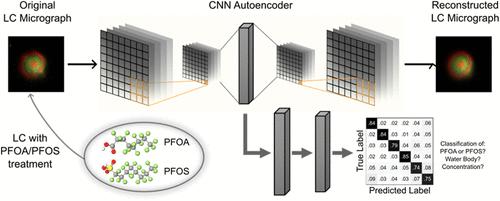机器学习辅助液晶液滴阵列平台对水中全氟烷基和多氟烷基物质(PFAS)的敏感和选择性检测
IF 9.1
1区 化学
Q1 CHEMISTRY, ANALYTICAL
引用次数: 0
摘要
我们报道了一个机器学习(ML)辅助液晶(LC)液滴阵列平台,用于检测水中的全氟烷基和多氟烷基物质(PFAS)。我们的方法使用一个自动编码器网络来处理从热致性lc的微尺度液滴阵列中获得的数千张图像。使用自动编码器获得的潜在空间包含重要信息,可以灵敏和选择性地检测两种两亲性PFAS[全氟辛酸(PFOA)和全氟辛烷磺酸(PFOS)],其浓度低至万亿分之一(ppt),存在于超纯水、市政自来水和含有溶解有机物的模拟河水中。尽管在低PFAS浓度下LC阵列的光学输出没有可见的变化,但这种方法可以准确预测它们的存在,即使在含有干扰分子的水中也是如此。我们还演示了使用迁移学习来区分全氟辛烷磺酸、全氟辛烷磺酸和全氟辛烷磺酸/全氟辛烷磺酸混合物,展示了实际环境监测的潜力。该平台允许识别低于美国环境保护署规定的最大污染物水平(4毫微克)的全氟辛烷磺酸和全氟辛烷磺酸。我们的方法与自动打印、处理、高通量光学和ML分析相兼容,可以为开发低成本传感器来监测真实水样中的PFAS和其他两亲性污染物提供基础。本文章由计算机程序翻译,如有差异,请以英文原文为准。

A Machine Learning-Assisted Liquid Crystal Droplet Array Platform for the Sensitive and Selective Detection of Per- and Polyfluoroalkyl Substances (PFAS) in Water
We report a machine learning (ML)-assisted liquid crystal (LC) droplet array platform for the detection of per- and polyfluoroalkyl substances (PFAS) in water. Our approach uses an autoencoder network to process thousands of images obtained from arrays of microscale droplets of thermotropic LCs. The latent space obtained using the autoencoder contains significant information that enables sensitive and selective detection of two amphiphilic PFAS [perfluorooctanoic acid (PFOA) and perfluorooctanesulfonic acid (PFOS)] at concentrations as low as parts-per-trillion (ppt) in ultrapure water, municipal tap water, and simulated river water containing dissolved organic matter. Despite the absence of visually discernible changes in the optical outputs of LC arrays at low PFAS concentrations, this approach accurately predicts their presence, even in water containing interfering molecules. We also demonstrate the use of transfer learning to differentiate between PFOA, PFOS, and PFOA/PFOS mixtures, showcasing the potential for practical environmental monitoring. This platform permits identification of PFOA and PFOS below the maximum contaminant levels (4 ppt) established by the U.S. Environmental Protection Agency. Our approach is compatible with automated printing, treatment, and high-throughput optical and ML analysis and could provide a basis for the development of low-cost sensors to monitor PFAS and other amphiphilic contaminants in real-world water samples.
求助全文
通过发布文献求助,成功后即可免费获取论文全文。
去求助
来源期刊

ACS Sensors
Chemical Engineering-Bioengineering
CiteScore
14.50
自引率
3.40%
发文量
372
期刊介绍:
ACS Sensors is a peer-reviewed research journal that focuses on the dissemination of new and original knowledge in the field of sensor science, particularly those that selectively sense chemical or biological species or processes. The journal covers a broad range of topics, including but not limited to biosensors, chemical sensors, gas sensors, intracellular sensors, single molecule sensors, cell chips, and microfluidic devices. It aims to publish articles that address conceptual advances in sensing technology applicable to various types of analytes or application papers that report on the use of existing sensing concepts in new ways or for new analytes.
 求助内容:
求助内容: 应助结果提醒方式:
应助结果提醒方式:


